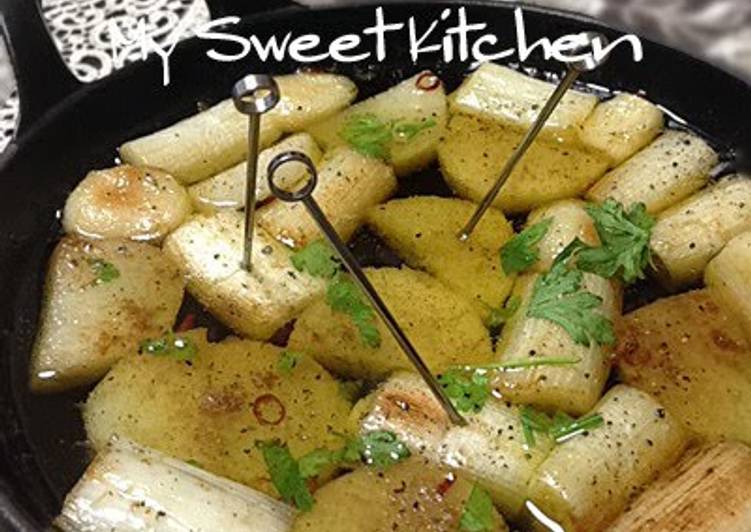Ajillo with Japanese Leek and Nagaimo. Nagaimo is a tuber that when grated has a lovely slimy foamy texture. Today I'll show you how to prepare it in a Japanese dish cold soba noodles called. Great recipe for Fluffy Kansai-style Okonomiyaki with Cabbage and Nagaimo Yam.
 There is some confusion between the two Japanese terms yamaimo and nagaimo, which are actually two distinct species of yam although the two names are often.
Nagaimo is very slimy and slippery, so be careful.
I don't get allergic reactions but get itchy a little bit.
You can Have Ajillo with Japanese Leek and Nagaimo using 10 ingredients and 17 steps. Here is how you cook it.
There is some confusion between the two Japanese terms yamaimo and nagaimo, which are actually two distinct species of yam although the two names are often.
Nagaimo is very slimy and slippery, so be careful.
I don't get allergic reactions but get itchy a little bit.
You can Have Ajillo with Japanese Leek and Nagaimo using 10 ingredients and 17 steps. Here is how you cook it.
Ingredients of Ajillo with Japanese Leek and Nagaimo
- Lets Go Prepare 250 ml of Extra virgin olive oil (look at Step 14).
- It's 1 of bulb Garlic (peel each clove/ look at Step 16)...A.
- Lets Go Prepare 50 cm of long Japanese leek (cut into 4 to 5-cm lengths).
- Lets Go Prepare 5 cm of long Nagaimo (peel and slice into 1 cm thick half rounds or quarter rounds if it is large).
- Lets Go Prepare 1 of Red chilli (sliced)...B.
- Lets Go Prepare 3 of to 4 Anchovy fillets...B.
- Lets Go Prepare 1 of Natural Salt (or Krazy Salt) …C.
- Lets Go Prepare 1 of Oregano...C.
- Lets Go Prepare 1 of Black pepper.
- What You needis 1 of Italian parsley (other herbs or none).
Some of you may experience itch when you touch it with I usually use grated nagaimo to make Okonomiyaki. batter. Grated nagaimo has lots of air in it and when you cook with it, the food gets fluffy and airy, perfect. Nagaimo is one of my favorite Japanese vegetables and with the perpetual popularity of Japanese cuisine, nagaimo continues to gain more visibility in the West. It is a Japanese yam that, unlike other yams which can only be eaten cooked, can be eaten either cooked or raw.
Ajillo with Japanese Leek and Nagaimo step by step
- Put A ingredients into a cold frying pan. Place over a low heat. Cook slowly until the garlic and Japanese leek infuse their flavour into the oil..
- When the bottom parts of the garlic and Japanese leek soaked in oil are golden brown, turn over. If they are not cooked evenly, swap the positions..
- After turning over Step 2, add the B ingredients. Cook slowly over a low heat. Anchovies are going to melt down slowly..
- When the garlic and nagaimo are tender, turn the heat off. Stir quickly and check the taste. Season with the C ingredients..
- [Additional note] Even if you use the same amount of anchovies, the amount of salt which the ingredients will absorb differs according to the timing at which you add the anchovies..
- According to one user, you can season the ajillo by adding a little chopped anchovies along with the C ingredients in Step 4..
- When it tastes the way you like, add the Italian parsley and bring back to the boil quickly..
- Sprinkle with coarsely ground black pepper and serve while very hot. Serve with French baguette..
- I love this sweet and soft Japanese leek. Japanese leek is a staple ingredient for my ajillo dishes..
- You won't believe how tender and fluffy the nagaimo will be...for ajillo, I prefer nagaimo to potatoes..
- Usually you add chopped garlic to ajillo but I like it with them as whole cloves because they will be fluffy and tasty. It is a great combination with anchovies..
- I usually serve ajillo in the same dish I cooked with. Or you can make a large batch and divide into small ramekins. You can use any dishes you like to serve this..
- For ajillo with Japanese leek, dried tomatoes and seafood in a 10 cm pot. Look at this recipe to know the resultant quantity you will make. https://cookpad.com/us/recipes/147338-ajillo-with-japanese-leek-and-dried-tomatoes.
- [Additional note] The amount of olive oil in Step 1 is suitable for a 20-cm grilling pan, and this covers half of the 2 cm in diameter Japanese leek..
- By adding the nagaimo later in this recipe, plenty of oil will be left in the resultant dish as in the profile photo. Add more oil if you like..
- If you add more oil, add more anchovies too.has more oil. Adjust the amounts accordingly... https://cookpad.com/us/recipes/147338-ajillo-with-japanese-leek-and-dried-tomatoes.
- I used whole cloves of garlic but use chopped garlic if you prefer. If so, reduce the amount to 2 cloves..
Nagaimo is also known as Chinese yam. Yamaimo/Nagaimo/Tororoimo is a type of yam that can be eaten raw and is used frequently in Japanese cooking. This confused me when I was a child because my grandmother always called it Tororoimo but my mom would mix it up and call it Nagaimo and Tororoimo. In Japanese, a common method that is taught for learning right from left is that the kanji for both include a hand "holding" something. 右 Migi (Right) holds a mouth 口. 左 Hidari (left) holds a symbol that means craft or skill (工). Turn over and bake till good colour.